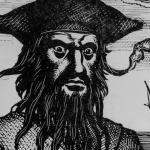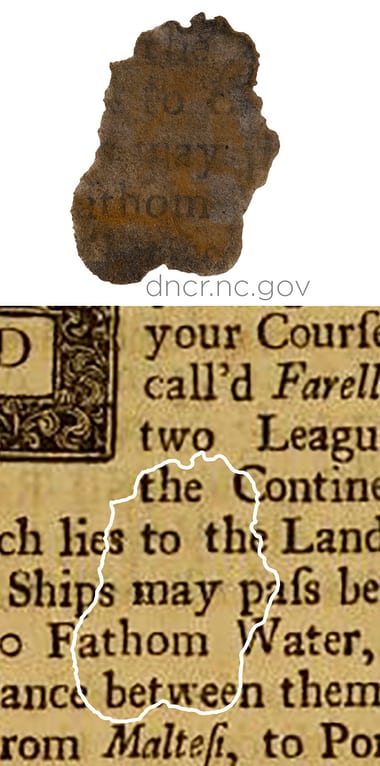Fragments of Book Recovered from Wreck of Blackbeard's Ship

The notorious 18th-century pirate Blackbeard may have whiled away the hours between raids by curling up with a good book, according to a new discovery.
Archaeological conservators in North Carolina working on the wreckage of Blackbeard’s flagship, the Queen Anne’s Revenge, found 16 tiny fragments of paper “in a mess of wet sludge” that had been in the chamber of a cannon. They worked for months to conserve the fragments, the largest of which was the size of a US quarter, discovering as they worked that a few words were still visible on some of the fragments.
After months of work, the researchers have determined that the fragments came from the 1712 book by Captain Edward Cooke, A Voyage to the South Sea, and Round the World, Perform’d in the Years 1708, 1709, 1710 and 1711.

Paper fragment matched to text in Edward Cooke’s book. North Carolina Department of Natural and Cultural Resources
The conservators, who work for the North Carolina Department of Natural and Cultural Resources’s QAR lab, said that paper very rarely survives on shipwreck sites.
“This unique find from the wreckage of Queen Anne’s Revenge provides archaeological evidence for books carried on ships in the early 18th century, and adds to our knowledge of the history of Blackbeard’s flagship and those who sailed her,” said the department. “The historical record has several references to books aboard vessels in Blackbeard’s fleet, but provides no specific titles; this find is the first archaeological evidence for their presence on QAR.”
Blackbeard, whose real name was Edward Teach, ran the Queen Anne’s Revenge aground in 1718 off the coast of North Carolina. The wreck was discovered in 1996, and conservators have been working to find and preserve artefacts from the vessel ever since.
“It’s so unusual to get any organic material like paper surviving,” said historian Angus Konstam, author of a biography of Blackbeard. “The worrying thing is that one option to keep the powder charge in place in a cannon was to wedge it with paper. The book lover in me hates the fact that the pirates might have torn out a page from a book in order to fire their gun.”
But Konstam said that the subject matter of the book, a “voyage narrative” describing Cooke’s adventures around the coast of South America, would have been “pretty good bedtime reading for a pirate”.
The book also features the rescue of Alexander Selkirk from an island in the South Pacific on which he had been marooned for four years – a story that would inspire Daniel Defoe’s 1719 novel Robinson Crusoe.
“Who knows? Teach might have had a penchant for travel and adventure books,” said Konstam.
Historian Simon Layton said many pirates in Blackbeard’s time could read and often took books while plundering. “That said, finding these pages down the shaft of a cannon doesn’t necessarily imply that Blackbeard’s crew were absorbed in such literature! One could argue conversely, that it reveals a certain irreverence towards books in general. But pirates were, after all, a motley crew; undoubtedly some were better read than others.”
“Although books such as these voyage narratives would have been relatively common on ships of the early 18th century, archaeological evidence for them is exceedingly rare, and this find represents a glimpse into the reading habits of a pirate crew,” said the conservators, who are planning a display about the find to mark Blackbeard’s 300th anniversary this year.
